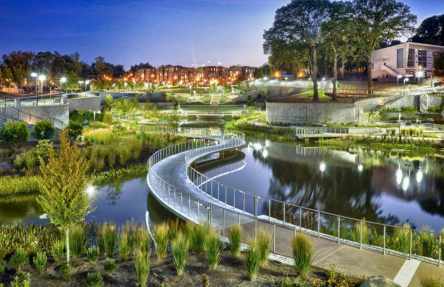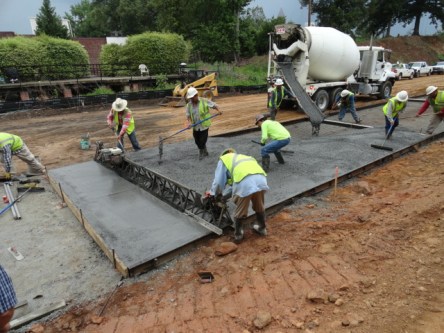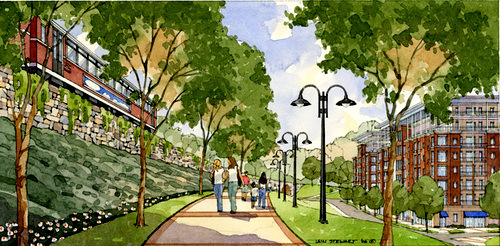Atlanta City Councilman Andre Dickens proposes a revised zoning ordinance along the Atlanta BeltLine, a 22-mile mixed-use park project. It is the first step in a longstanding effort to prepare for the city’s 40 percent population boom by 2040. The proposal would require developers along the BeltLine to designate a percentage of units towards affordable housing for the next 20 years. Developers would receive incentives for their compliance, such as reduced property taxes and more flexible parking requirements. Additional details remain undisclosed. The push for affordable housing in Metro Atlanta, particularly in the Buckhead segment of the BeltLine, addresses a desperate need. Buckhead View reports the most recent data: A person or family whose income falls below 80 percent of the Atlanta Metropolitan Statistical Area Median Income (AMI) qualifies for subsidized housing. The median income for a family of four is approximately $67,500. Per the United States National Housing Act of 1937 for affordable housing, allotting one-third of one’s income is reasonable for housing costs. That would be $24,300 a year or an average rent of $680 per month for Atlanta families. Along the BeltLine in Buckhead, an 800 square-foot studio could cost a family more than $1,840 per month. Rents exceed $2.30 per square foot, according to Haddow & Co. Home prices continue to rise. A report issued by Georgia Tech reveals that home sales prices near the BeltLine increased faster than elsewhere in Metro Atlanta. Prices skyrocketed between 40 to 68 percent in the last four years, depending on the neighborhood. High prices are largely the results of land costs. Chuck Young, SVP of development for the Prestwick Development Co., notes the steady rise in recent years. “It used to be we could develop a garden apartment for $65 a square foot. Now it’s...
Atlanta BeltLine
Early Completion Expected
The Atlanta BeltLine’s Westside Trail is slated to finish two to three years earlier than expected, even with a few delays due to a rainy summer this year. The good news comes after the project received a recent wave of grants. The US Department of Transportation awarded an $18 million grant in early September. Called Tiger V, the grant will supply about 42 percent of the project’s total cost. This is a huge step for the BeltLine. With the funds, an additional 2.5 mile portion of the trail’s southwest corridor will be completed. To access the trail, residents and guests will gain access to 16 ADA accessible entry points as well as pedestrian overpasses at nine crossroads. Upon receiving the grant, Mayor Kassim Reed lauded the project as “one of the most transformative projects ever undertaken in our city’s history.” He continued, “This $18 million grant is a tremendous step forward in my administration’s goal to make the vision of the Atlanta BeltLine a reality much sooner.” Paul Morris, President and CEO of Atlanta BeltLine, Inc., expressed his gratitude for the award. “We are extremely grateful to the U.S. DOT for this opportunity to deliver such a significant part of the Atlanta BeltLine in southwest Atlanta years ahead of schedule,” said Morris. In mid-September, the BeltLine received a $20,000 grant from REI, which is double the outdoor supplier’s contribution last year. The funds will be allocated towards new mile markers and signage along an 8.2 portion of the trail. Funds will also be set aside for ongoing management operations. To keep the extensive trail network safe and enjoyable for everyone, the BeltLine has received its own security force. The Path Force formed this July after receiving a $1.8 million grant from the U.S. Department of...
Atlanta’s BeltLine
Improving quality of life
In the quest for a healthier, more transit-friendly Atlanta, a growing grassroots movement is backing the BeltLine plan. The Atlanta BeltLine, which includes 1,300 acres of parks, 33 miles of multi-use trails, 22 miles of rail transit, and 5,600 units of affordable housing, has grown from a seedling in the mind of a Georgia Tech student into a full-fledged redevelopment movement supported by civil leaders, residents, and national environmental organizations. Repurposed historic railway corridors and remediated brownfield make up the backbone of the BeltLine, accompanied by the addition of new parks and trails that unite various parts of the city into one, easily accessible whole. The BeltLine has caught the attention of multiple media outlets, and recently earned praise from The Sierra Club’s Smart Choices, Less Traffic report, where it was heralded as one of the nation’s finest examples of eco-conscious transportation initiatives. “If they pull it off, and I think they will, it will be a model, and pull them out of the economic doldrums they are in,” said Chris Leinberger, a leading scholar and expert on walkable urbanism. “The BeltLine is going to save the city of Atlanta and become a major economic generator for the entire region.” Most civic support has been poured into the transit lines. The BeltLine holds the ability to make the neighborhoods of Atlanta more accessible and united. A poorly developed public transit system and mind-numbing traffic (Atlanta tops Forbes’ “Worst Cities for Commuters List”) currently locks residents within their neighborhoods and suburbs. To ease transportation woes, the BeltLine will connect 45 neighborhoods via rapid rail transit, merging with existing MARTA systems to extend access to the city’s suburbs. As each segment of the BeltLine reaches completion, more residents can enjoy abbreviated commute times. Improved public transit will also reduce Georgian’s dependency on personal motorized vehicles and the carbon footprint that they leave behind. While the transit line holds the greatest appeal for most Atlantans, it is also the source of the most contention. BeltLine progress has been vastly determined by referendums, the most recent of which failed to gain sufficient support. TSPLOST, which would have added a 1 percent sales tax to raise funds for portions of the project, was declined. Impeded but not deterred, leadership plows forward with the plan. Small victories, such as the recent Old Fourth Ward land acquisition, have kept the BeltLine vision alive. Earlier this year, Atlanta BeltLine Inc. purchased .76 acres of land from The Trust for Public Land. Though insubstantial in size, the space will make a huge impact on the BeltLine’s cohesion. The property will connect the new Eastside Trail with Historic Fourth Ward Park, allowing pedestrians a clear connection to Piedmont Park, Freedom Park Trail, and Jimmy Carter Presidential Library complex. Construction is slated for completion in 2014. Overtime, the Historic Old Fourth Ward property will connect with six existing parks. Researchers have realized that no single type of green space completes a snapshot of a healthier Atlanta, which is a secondary BeltLine goal. Walkability requires a combination of parks, urban gardens, playgrounds, woodlands, alternative transit routes and community plazas to develop an urban culture that is environmentally responsible and promotes residents’ physical and mental health. This spring, Atlanta BeltLine is collaborating with the City of Atlanta to replace the Edgewood Avenue bridge. Pedestrian walkways will be added to the new structure. By April 2014, the new Edgewood Avenue bridge will connect the Eastside Trail to Lake Avenue, DeKalb Avenue, and Irwin Street. This small link in the chain proves to be as important as any other, improving pedestrian access to multiple neighborhoods and their resources. To connect the various parks and residential corridors, a 33-mile network of multi-use trails is in the works. Fortunately for project planners, 22 miles of the trails were previously used for the railroad, thus offering relatively clear and maintained grounds upon which to build. Other portions...



